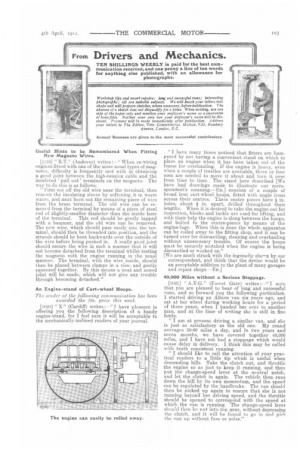From Drivers and Mechanics.
Page 21

If you've noticed an error in this article please click here to report it so we can fix it.
TEN SHILLINGS WEEKLY is paid for the best communication received, and one penny a line of ten words for anything else published, with an allowance for photographs.
Useful Hints to be Remembered When Fitting New Magneto Wires.
[1019] " R.T." (Andover) writes :—" When re-wiring engines fitted with one of the more usual types of magnetos, difficulty is frequently met with in obtaining a good joint between the high-tension cable and the insulated 'pull out' terminals on the magneto. The way to do this is as follows.
" First cut off the old wire near the terminal, then remove the insulating sleeve by softening it in warm water, and next burn out the remaining piece of wire from the brass terminal. The old wire can be removed from the terminal by means of a piece of steel rod of slightly-smaller diameter than the inside bore of the terminal. This rod should be gently tapped with a hammer, and the old wire can be removed. The new wire, which should pass easily into the terminal, should then be threaded into position, and the strands should be bent backwards over the outside of the wire before being pushed in. A really good joint should secure the wire in such a manner that it will not become detached from the terminal whilst testing the magneto with the engine running in the usual manner. The terminal, with the wire inside, should then be placed between clamps in a vice, and gently squeezed together. By this means a neat and sound joint will be made, which will not give any trouble through becoming detached."
An Engine-stand of Cart-wheel Hoops.
The sender of the following communication has been awarded the 108. prize this week.
[1020] "X" (Cardiff) writes:—" I have pleasure in offering you the following description of a handy engine-stand, for I feel sure it will be acceptable to the mechanically-inclined readers of your journal. "I have many times noticed that fitters are hampered by not having a convenient stand on which to place an engine when it has been taken out of the frame for overhauling. If the engine is heavy, even when a couple of trestles are available, three or four men are needed to move it about and two it over from time to time. The stand here described [We have had drawings made to illustrate our correspondent's meaning.—En.] consists of a couple of broad iron cart-wheel hoops, fitted with angle irons across their centres. These centre pieces have 4 in. holes, about 4 in. apart, drilled throughout their lengths. When it is desired to take the engine out for inspection, blocks and tackle are used for lifting, and with their help the engine is slung between the hoops, and bolted to the centre-pieces by means of the engine-lugs. When this is done the whole apparatus can be rolled away to the fitting shop, and it can be turned over for dismantling, cleaning and overhauling without unnecessary trouble. Of course the hoops must be securely scotched when the engine is being dismantled or worked on."
[We are much struck with the ingenuity sho-m by our correspondent, and think that the device would be an acceptable addition to the plant of many garages and repair shops.—En.] 40,000 Miles without a Serious Stoppage.
[1021] " A.E.G." (Forest Gate) writes :—" I note that you are pleased to hear of long and successful runs, and so forward you the following particulars. I started driving an Albion van six years ago, and sat at her wheel during working hours for a period of three years, when I handed her over to another man, and at the time of writing she is still in fine fettle.
"I am at present driving a similar van, and she is just as satisfactory as the old one. My round averages 50-60 miles a day, and in two years and seven months, we have covered together 40,000 miles, and I have not had a stoppage which would cause delay in delivery. I think this may be called with truth consistent running.
"I should like to call the attention of your practical readers to a little tip which is useful when descending hills. Take the clutch out, and throttle the engine so as just to keep it running, and then put :the change-speed lever at the neutral notch, and let the clutch in again. The vehicle then runs down the hill by its own momentum, and the speed can be regulated by the handbrake. The van should then be picked up again to ensure that she is not running beyond her driving speed, and the throttle
should be opened to correspond with the speed at which the van is running. The change-speed lever should then he nut into top gear, without depressing the clutch, and it will he found to go in and pielc the van up without fuss or noise."






















